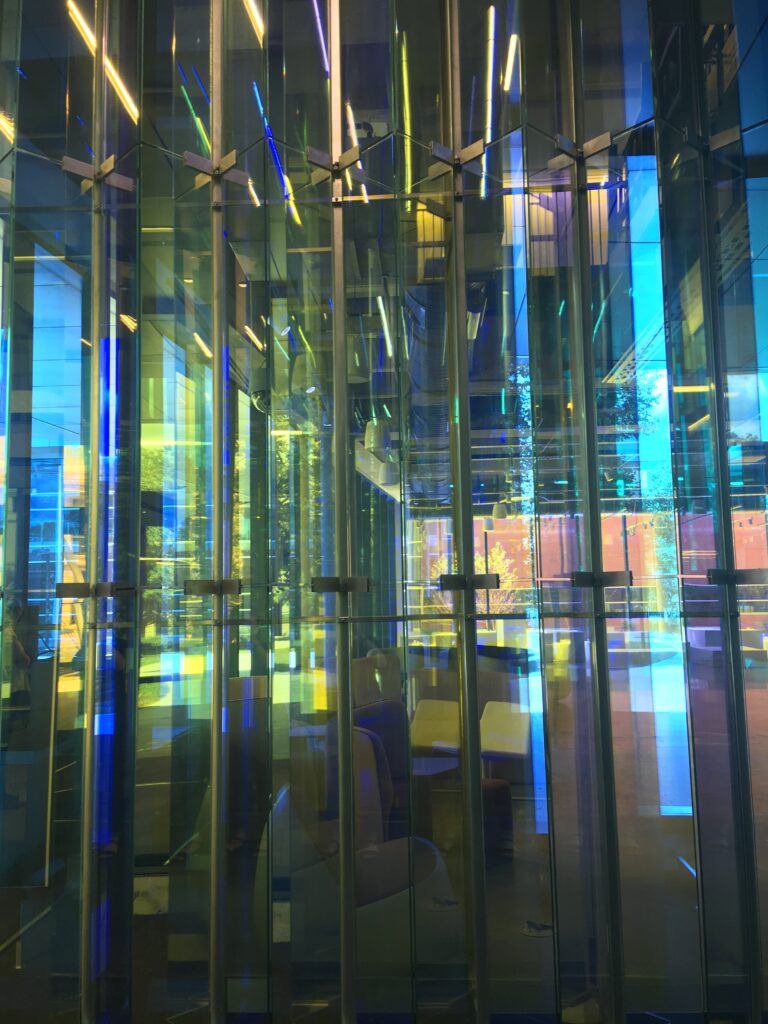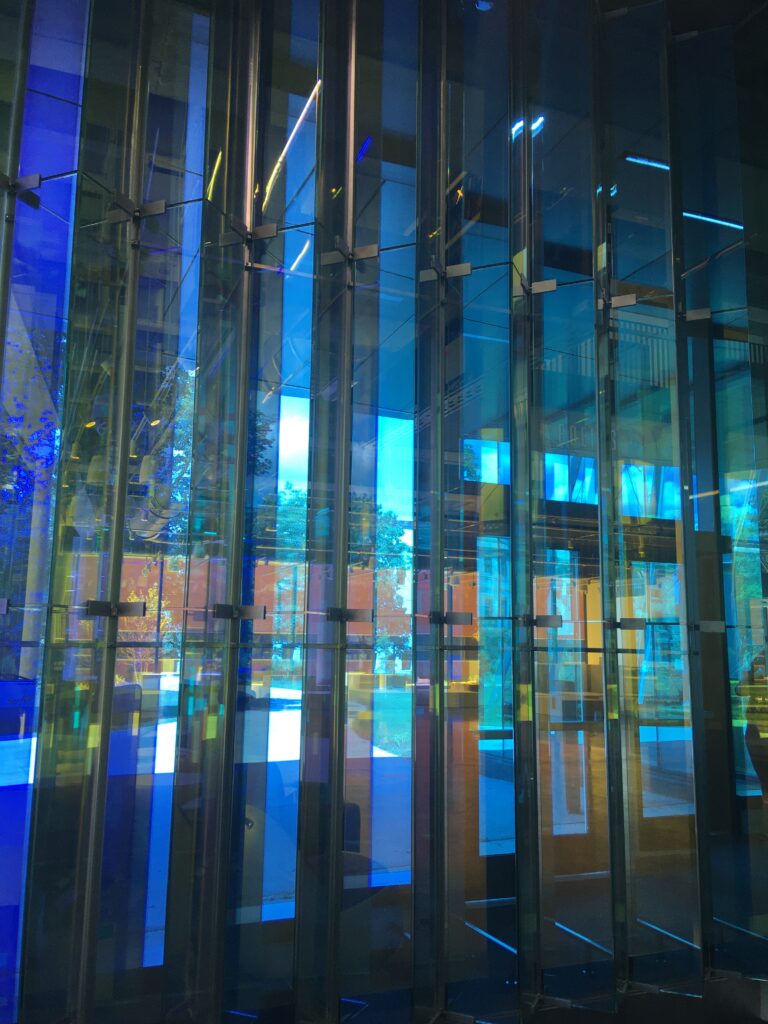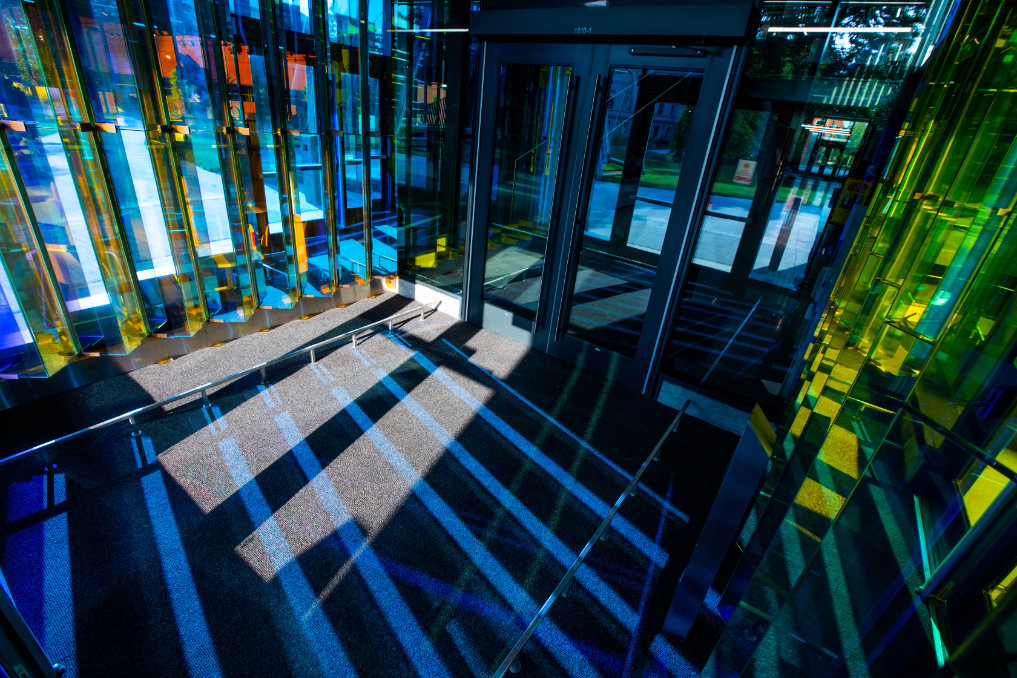

About the Art
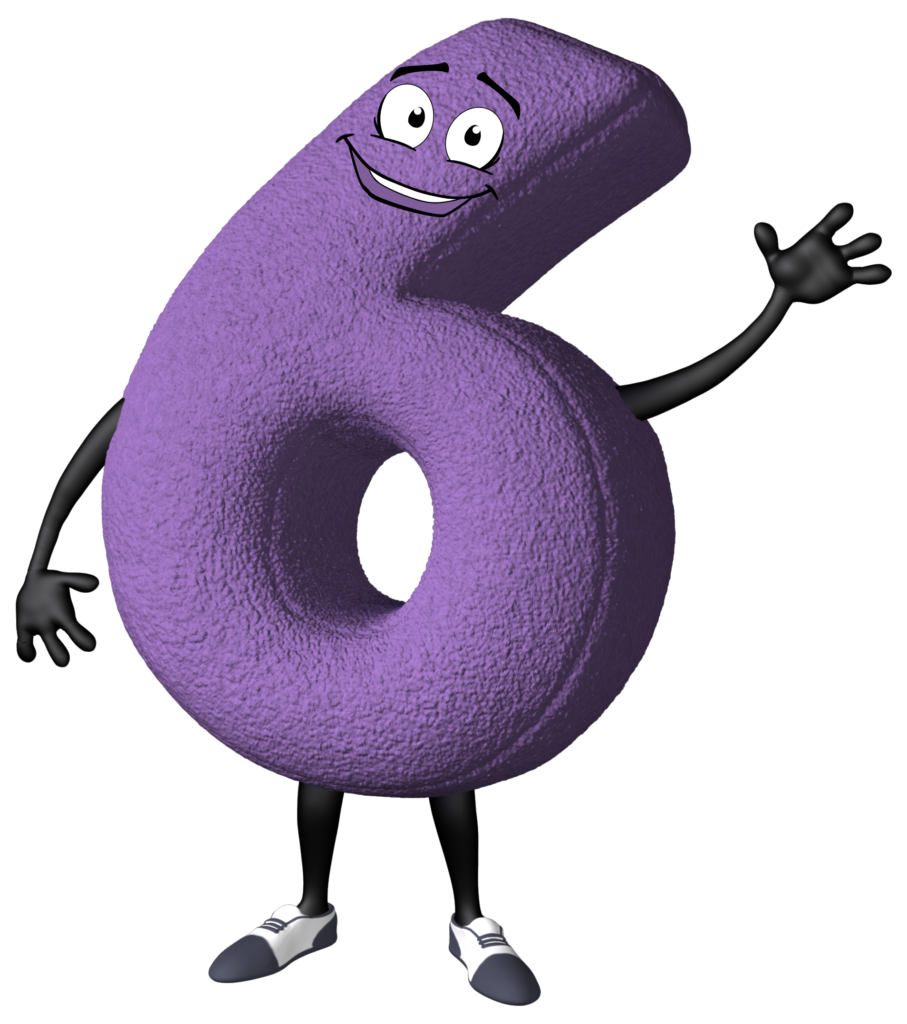
At Iowa State University’s Innovation Center, Catherine Widgery constructed Interface in 2021. In 2023 Iowa State University was named Entrepreneurial University of the Year with the Innovation Center playing a central role in receiving the award.
Integrated into the building’s architecture, Interface begins when the viewer enters the Innovation Center. Greeted by pleated dichroic glass walls that break up and reconfigure our surroundings, viewers see themselves in relation to the world around them. Anyone passing through the hallway is reflected multiple times in shifting fragments, a visually rich and ever-changing experience.
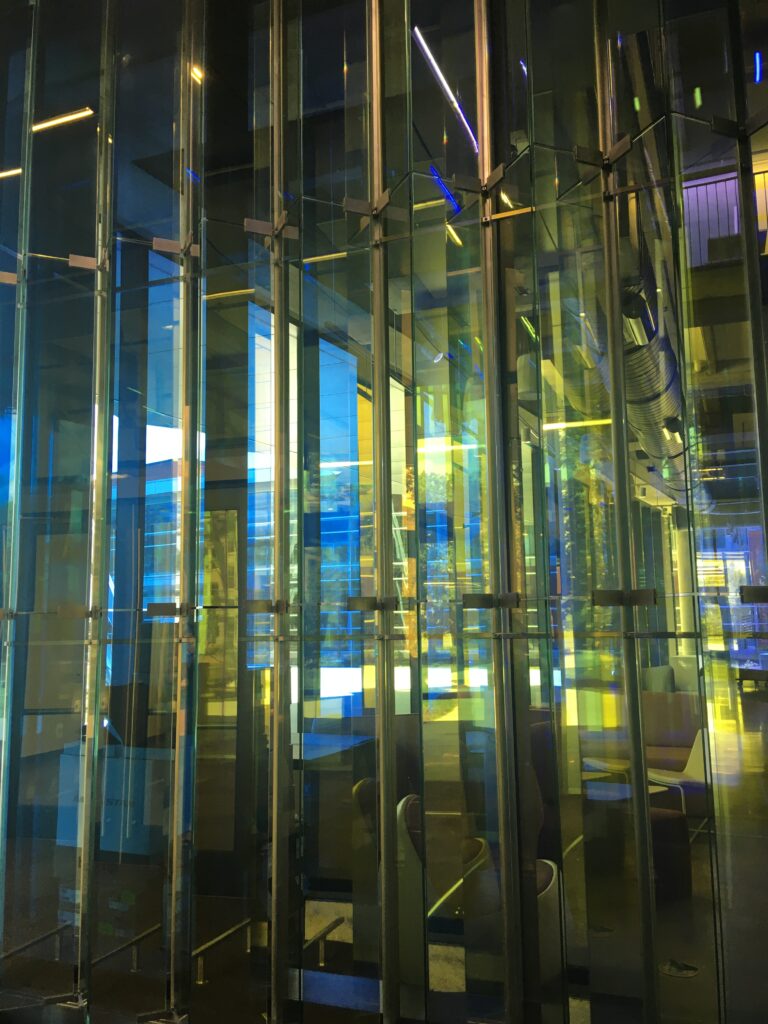
The second part of the installation is located in the interior courtyard on the second level. A series of suspended copper panels float above creating a canopy visible from all angles. The panels provide an open shelter as they have been cut in a chevron pattern. The panels echo the forms found in the building façade and the pleated forms of the entryway artwork. Within the floating panels are thousands of tiny LED lights linked via computer software to an anemometer mounted on the building roof. The anemometer measures wind speed and direction; the LED lights dim and brighten in sequence with the energy produced by the wind.
The installation embodies the interface of technology at the threshold between the natural and human built world. Interface showcases Iowa State University’s wish for innovative technology to be part of the students’ exploration.
About the Artist
Catherine Widgery was born in 1953 and grew up in Pittsburg, Pennsylvania. Widgery’s childhood included exploring the forests and creeks around her family’s home and wandering by rivers and steel mills each day on the way to school in suburban Pittsburgh. This mixture of nature with a man-made urban environment shaped her perceptions of the ever-changing balance between the two. This is demonstrated not only in Interface but also in her other site-specific public works of art (see below).
Widgery has built her career around making public art that is site specific. Nature’s energies and a viewer’s participation determine the art in any given moment. Over the years, Widgery and her team have created more than 50 site-specific public art projects across the US and Canada. Her specialties include wind, light, water, and computer-controlled lighting programs that communicate energy and animate the space within the environment.
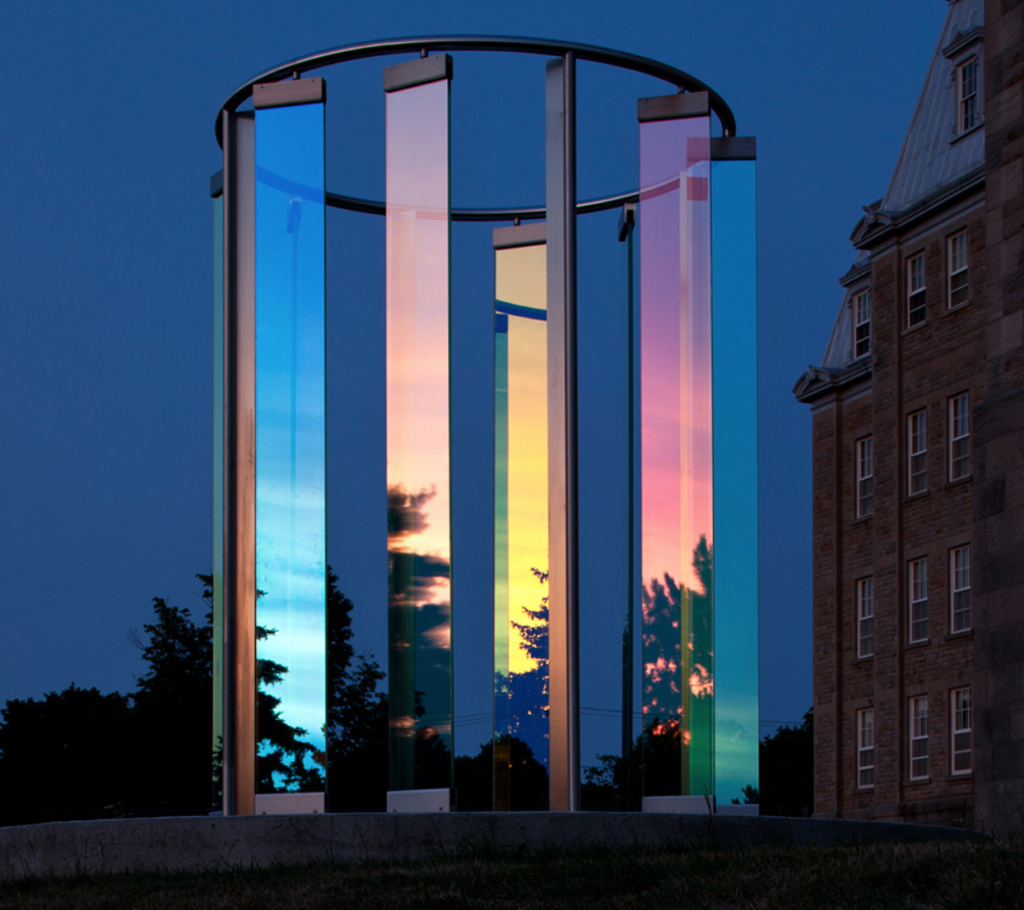
Halo, 2012, College Bourget de Rigaud, Quebec, Canada
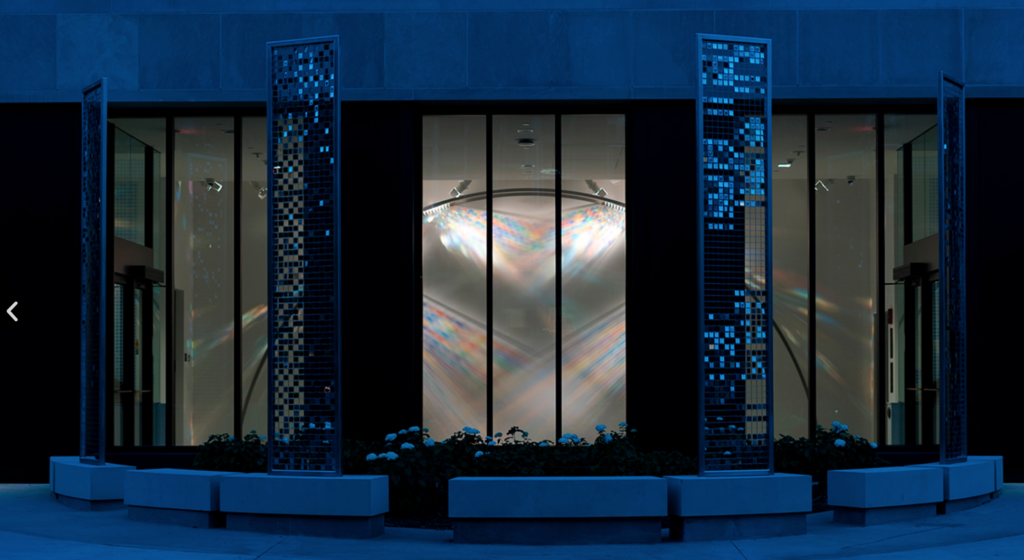
Deterministic Chaos, 2017, Tate Science Building University of Minnesota, Minneapolis, Minnesota
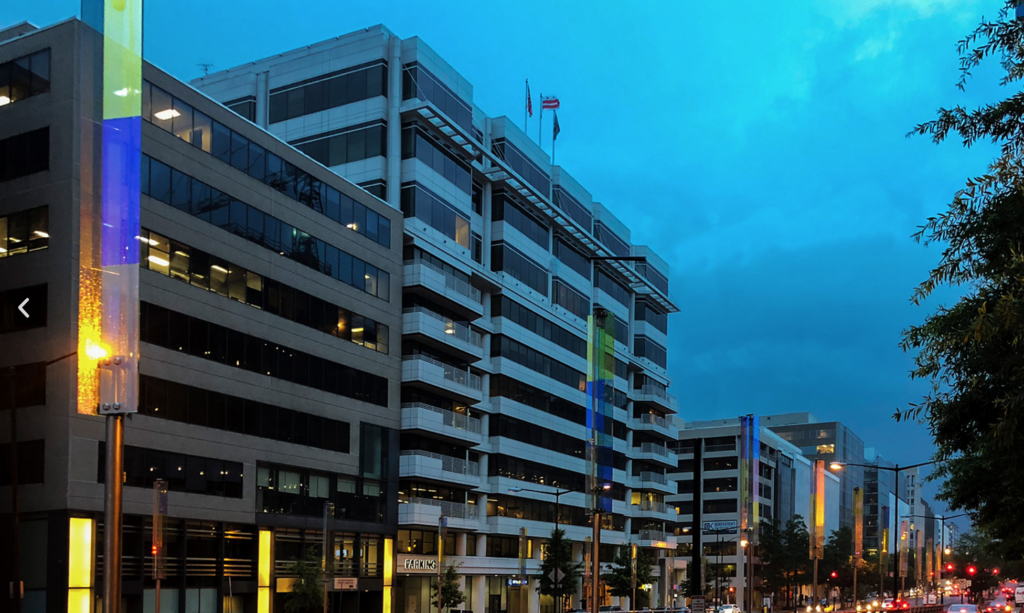
Leading Lights, 2018, Golden Triangle, Washington, DC
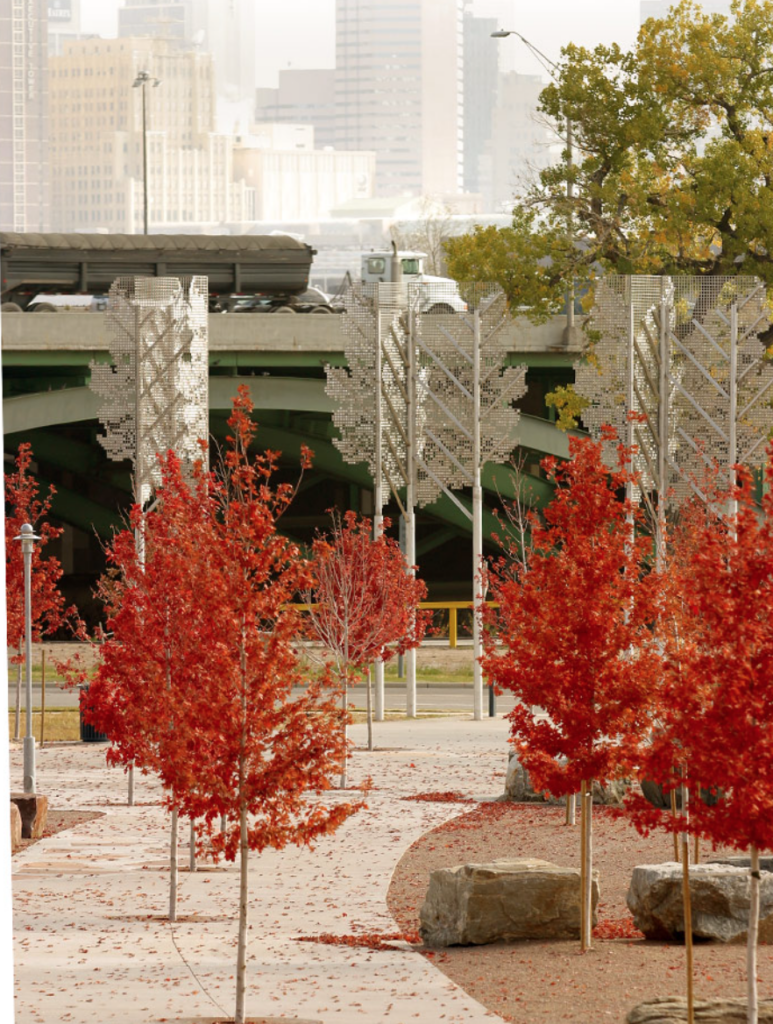
Pass through the Land, 2001, Mountainscape and Aspen Towers, Denver, Colorado
Relevant Terminology/History
Interface is the point where two systems, subjects, or organizations, meet and interact. It is a connection between two pieces of electronic equipment, or between a person and a computer.
The Student Innovation Center at ISU is a hands-on hub for Iowa State students of all programs and majors. This collaborative facility provides a unique, state-of-the-art space for students to exercise their innovative and entrepreneurial muscles — to design, fabricate, test, and demonstrate ideas for everything from culinary to lunar to digital gaming to vehicles. The facility, which opened its doors in fall 2020, also includes exhibit space, print and supply shops, a student-run retail shop and cafe, office space for student organizations, and a plethora of wireless access points.
Dichroic glass is glass which can display multiple different colors depending on lighting conditions. The name comes from the Greek roots, “di” meaning two and “chroma” meaning colors. Color changing glass dates back to at least the 4th century CE although few pieces have survived. Some objects were made in Venice during the Renaissance. One of the most famous remaining items is the Lycurgus Cup (see below).
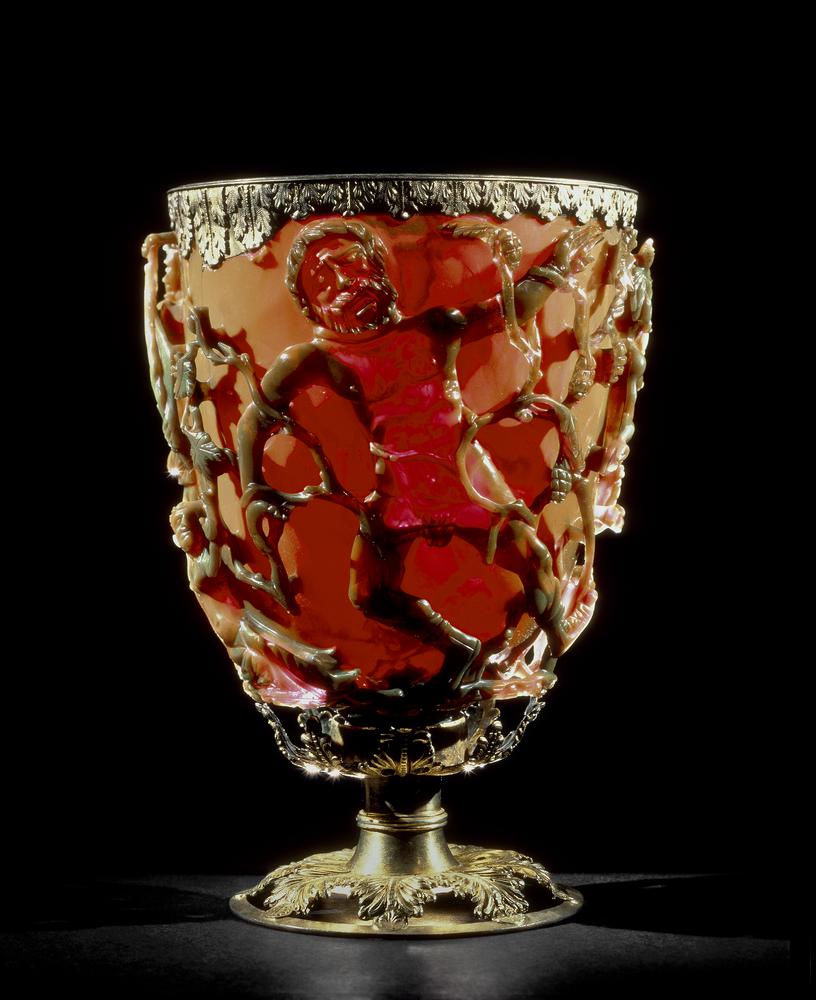
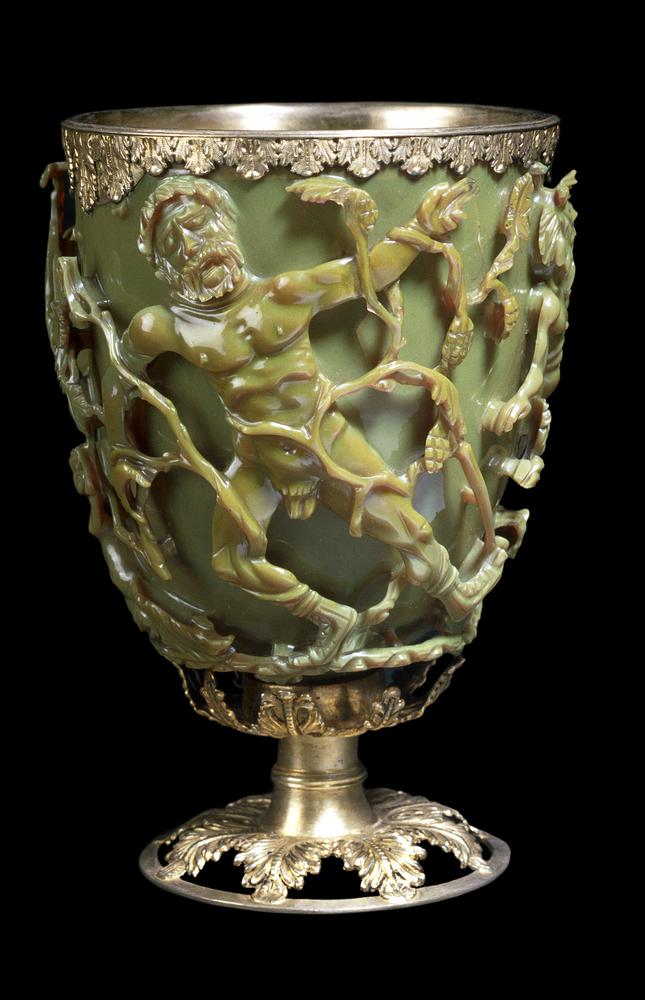
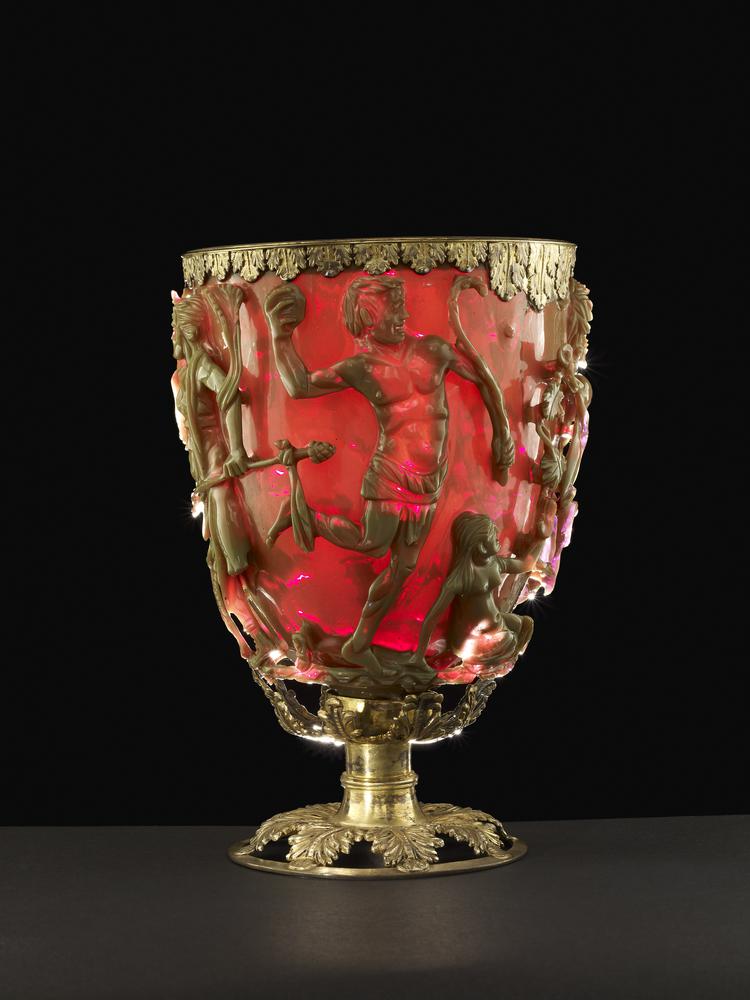
Lycurgus Cups, 4th century Roman glass cage cup made of dichroic glass, British Museum, London, England
Modern dichoric glass resulted from materials research carried out at NASA and its contractors who developed it for dichoric filters. Modern composite non-translucent glass is produced by stacking layers of metal oxides which give the glass shifting colors depending on the angle of view. It is displayed as an example of thin-film optics.
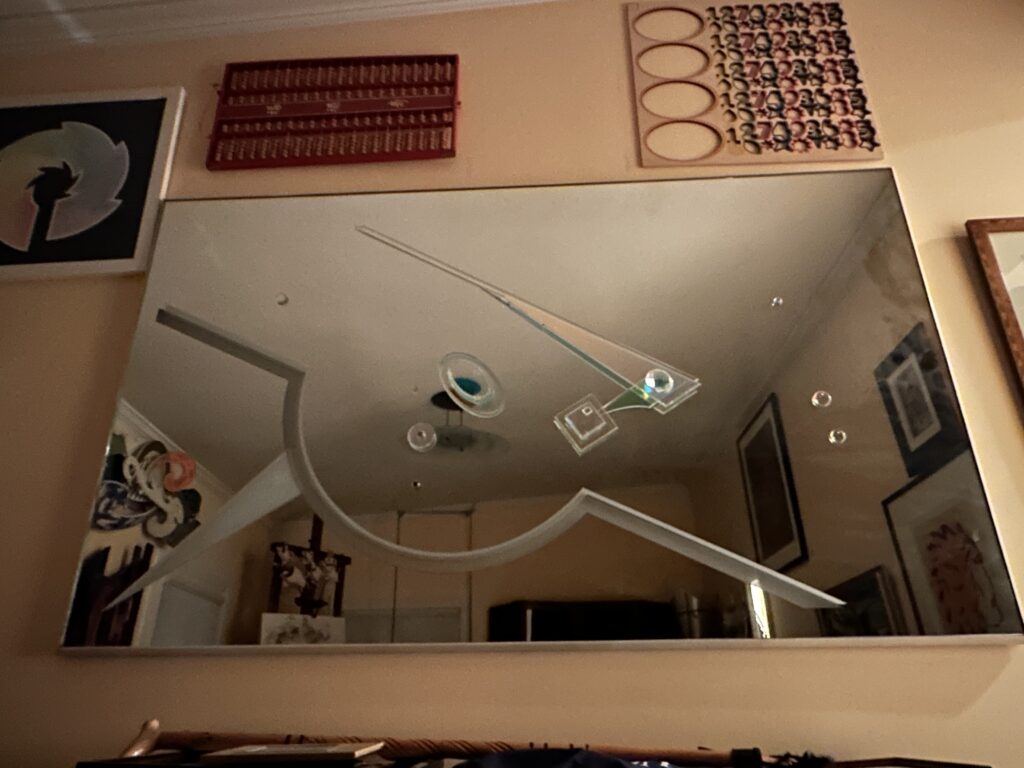
Mirror with dichroic glass, 1995, Creative Glass, commissioned by Dr. Klemm.
Glass artists often refer to dichroic glass as “dichro.” Examples of dichroic glass in architecture, other than Interface, can be seen at the corporate headquarters of Amazon.com in Seattle, Washington. It incorporates dichroic glass into the exterior of its high-rise building, reflecting light into various colors that depend on the time of day. The dichroic glass exterior of the Museum at Prairiefire in Overland Park, Kansas, was designed to reference the intentional prairie fires that was an integral part of farming life in Kansas.
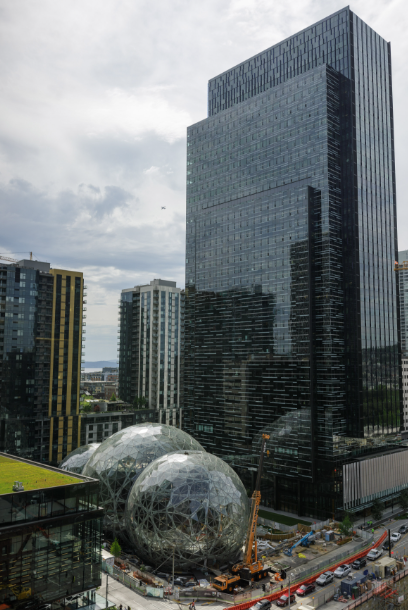
Amazon Headquarters, Seattle, Washington

The Museum at Prairiefire, 2014, Overland Park, Kansas
Prairie Fires are a natural and vital part of our ecosystem. They burn the soil and clear away all that has accumulated each year since gone to pass. Native American learned how to replicate the effects of natural lighting files in order to maintain the prairie ecosystem.
LED is a light-emitting diode is a semiconductor device that emits light when current flows through it. Electrons in the semiconductor recombine with electron holes, releasing energy in the form of photons. The color of the light is determined by the energy required for electrons to cross the band gap of the semiconductor
Chevron is a decorative pattern used in fabrics, floors and paneled wood which features a series of rectangles. Each rectangle has a diagonal width and adjacent to the width of the other. The result is a smooth zigzag formation of defined angles or points.

Image of chevron pattern
A vestibule is an antechamber, hall or lobby next to an outer door of a building or a chamber or channel opening into another.
Learning Guide
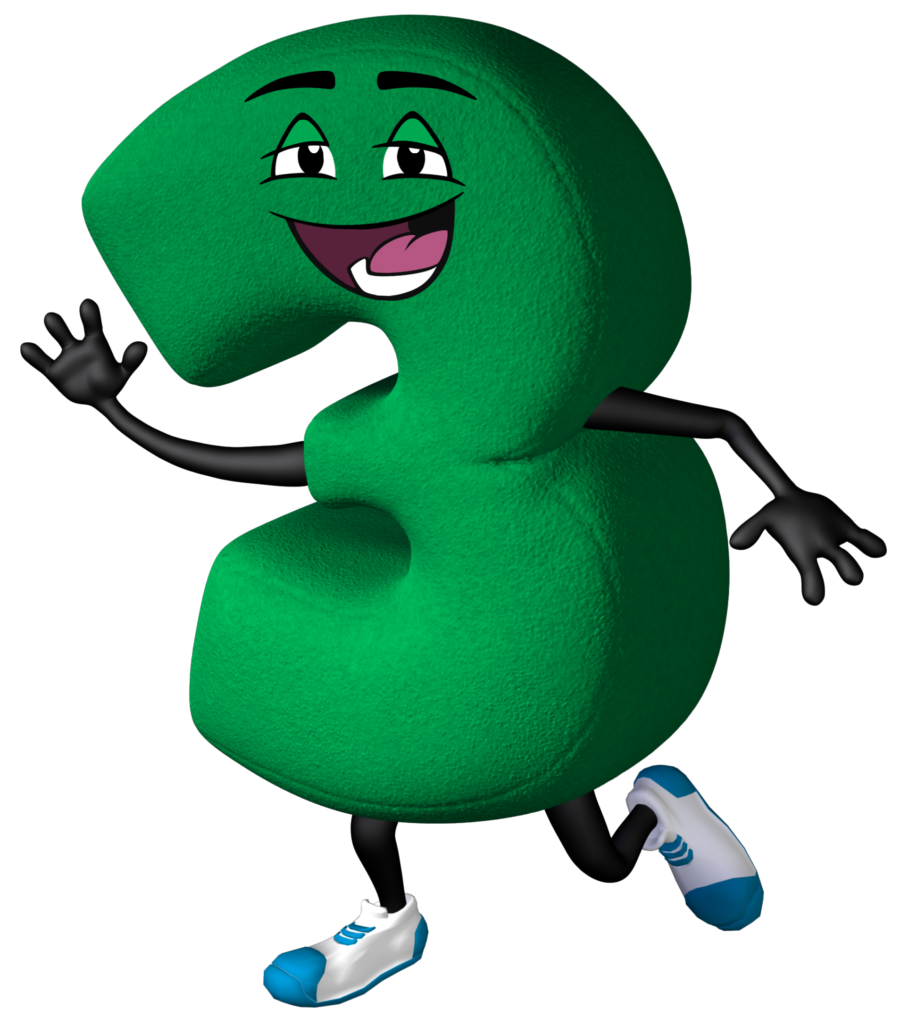
- What do you think the title has to do with the art?
- Why do you think Number Character 6 speaks about the art?
- Why do you think Number Character 3 speaks about the art?
- Why is Number Character 3 up in the air?
- How does the red image with white numbers relate to the art?
- How does the hidden blue image relate to the art? Can you find the hidden image in the architecture of the Innovation Center?
- Do you think both the positive and negative spaces of each panel could be called a chevron? Are chevrons a type of hexagon as Number Character 6 suggests?
- Can you count the number of chevron-like hexagons in Interface, or even one panel of Interface?
- Why do you think the panels of Interface are made from copper rather than wood? What other materials could Widgery have used besides copper?
- Can you see the dichroic glass on the book’s back cover as well as the spread in the book? Do you think it would be easier to see the dichroic glass during the day? Hint: See the daytime photos below and the evening and day photos at the top of the page.
- Have you ever seen a 3-dimensional triangular shipping tube that resembles the shape of the wall vestibules lined with dichroic glass? What kind of items are likely shipped in such boxes? What nice characteristic does such a tube have over a regular long tube with circles on each end?
